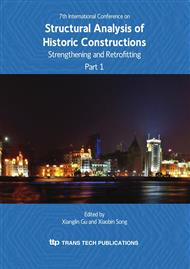p.665
p.671
p.677
p.683
p.689
p.697
p.703
p.709
p.715
Sensitivity of the Seismic Response of Long Medieval Walls to Earthquake and Material Uncertainty
Abstract:
The scope of this paper is to illustrate a strategy for assessing the seismic performance of medieval city walls with emphasis on the Byzantine Walls of the city of Thessaloniki. Despite the relatively simple structural system of such structures, their response under earthquake excitation in 3D space and in the time domain, has not yet been adequately studied primarily due to the lack of efficient numerical tools, the high computational cost associated and the uncertainty related to the spatial variation of material properties and seismic input motion characteristics. Nowadays, the advances in scientific knowledge and the increase in computational power, the ability to efficiently conduct sensitivity analyses and the deeper knowledge of earthquake engineering aspects, provides the opportunity for a more refined simulation and study; however, such approach still remains heavy enough and as such, unsuitable for all practical purposes. Along these lines, a comprehensive computational framework is established and presented herein that aims at quantifying the relative importance of the uncertainty associated with modeling parameters, structural and soil material properties, as well as the earthquake ground motion selection process and application assumptions, the latter refering to the consideration of different angles of incidence of the incoming seismic wavefield and the spatially variable nature of ground motion that excites asynchronously the particularly long historic structures. It is foressen that this detailed 3D dynamic analysis will assist in identifing the relative impact of earthquake characteristics and material properties, permit justified simplifications and facilitate the overall process undertaken by the authors to assess the seismic history of the city of Thessaloniki through a set of detailed back analyses of well-selected parts of the extended wall cirquit.
Info:
Periodical:
Pages:
689-695
Citation:
Online since:
October 2010
Price:
Сopyright:
© 2010 Trans Tech Publications Ltd. All Rights Reserved
Share:
Citation:


